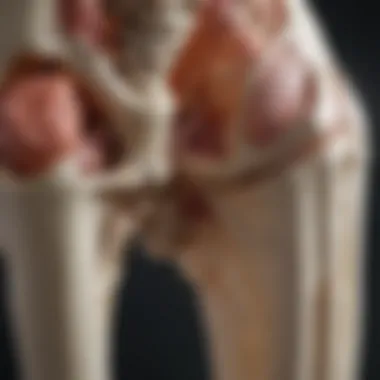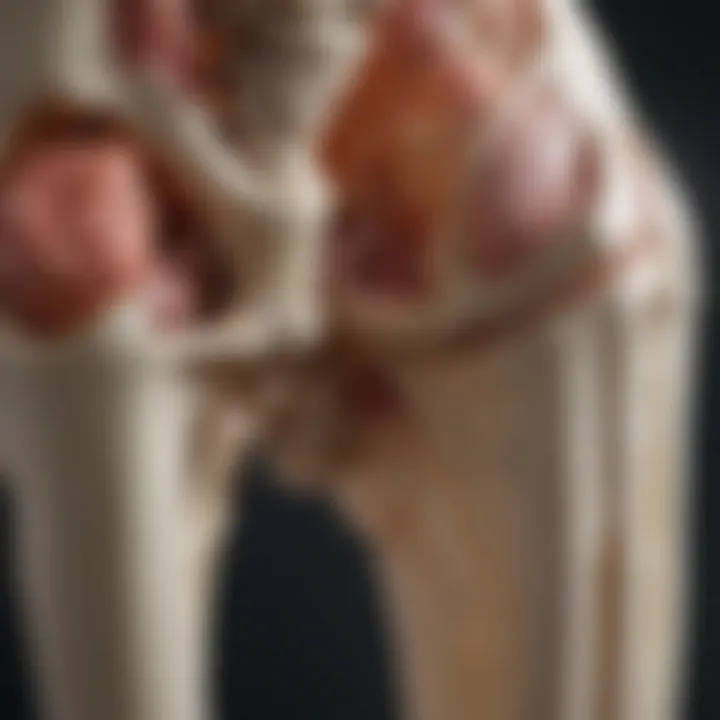Comprehensive Treatment Approaches for Osteoporosis Pain


Intro
Osteoporosis is a condition characterized by reduced bone density, increasing the risk of fractures. People with osteoporosis often experience various sorts of pain, particularly in the spine and hips. Understanding the treatment options for managing pain related to this condition is crucial. This article aims to explore these treatments in depth, offering insights into effective strategies for pain relief.
The management of osteoporosis pain requires a multifaceted approach. It involves both pharmacological and non-pharmacological interventions. Recognizing how these treatments interact with lifestyle changes can greatly improve patient outcomes. Moreover, it emphasizes the need for personalized treatment plans tailored to each patient's individual needs.
Article Overview
Purpose of the Article
The primary objective of this article is to provide a thorough understanding of the various treatment options for osteoporosis pain. It discusses both established and emerging therapies to help manage this often debilitating issue. By collating information and insights, the article aims to serve as a resource for students, researchers, educators, and professionals who are involved in osteoporosis care and pain management.
Relevance to Multiple Disciplines
The theme of osteoporosis pain management sits at the intersection of several disciplines. From medicine and nursing to physical therapy and nutrition, each field contributes essential insights into treating this condition. Understanding the implications of each discipline can help to design more effective treatment plans for patients.
Research Background
Historical Context
Historically, osteoporosis has been viewed largely as an age-related condition, primarily affecting post-menopausal women. As research has progressed, it is evident that osteoporosis can impact individuals across genders and age groups. Studies have emphasized the importance of early detection and intervention. As a result, the understanding of treatments for osteoporosis pain has evolved significantly over the past few decades.
Key Concepts and Definitions
To grasp the treatment options, certain concepts are essential:
- Osteoporosis: A medical disorder characterized by weakened bones and a higher risk of fractures.
- Pain Management: Strategies and treatments aimed at reducing chronic pain levels.
- Pharmacological Treatments: Medications used to alleviate pain or address bone density issues.
- Non-pharmacological Interventions: Therapies and lifestyle changes not involving medications, such as physical therapy and exercise.
Awareness of these terms is essential for comprehending the subsequent sections discussing specific treatments and their applications.
Overview of Osteoporosis
Osteoporosis is a bone disease characterized by decreased bone density and quality, leading to an increased risk of fractures. This condition often develops silently over years, making it particularly insidious. Understanding osteoporosis is crucial as it lays the groundwork for effective pain management strategies. Pain from osteoporosis is not just physical; it can significantly affect emotional health and overall quality of life.
Definition and Pathophysiology
Osteoporosis involves a disruption in the balance of bone resorption and formation. Osteoclasts, the cells that break down bone, become more active than osteoblasts, the cells that build bone. This imbalance results in thinner, weaker bones, which are prone to fractures, often occurring in the spine, hip, and wrist.
Several factors contribute to this condition. Genetic predisposition, hormonal changes, particularly after menopause, and nutritional deficiencies, such as low calcium and vitamin D intake, are notable contributors. Additionally, lifestyle factors such as insufficient physical activity and excessive alcohol consumption can exacerbate the problem. Being aware of these underlying mechanisms can be essential for effective treatment and prevention strategies.
Epidemiology and Demographics
Osteoporosis is a global health issue, affecting millions worldwide. It is particularly prevalent in postmenopausal women, but men are not immune to it. The risk increases with age, and certain populations, such as Caucasians and Asians, are at higher risk. Statistics indicate that around 1 in 3 women and 1 in 5 men over the age of 50 will experience an osteoporotic fracture. This demographic information is crucial for healthcare providers to identify at-risk individuals and design appropriate intervention strategies.
Understanding Osteoporosis Pain
Osteoporosis pain is a multifaceted issue that significantly impacts individuals living with this condition. Understanding the pain involved in osteoporosis is crucial for several reasons. First, osteoporosis itself is characterized by weakened bones, increasing the risk of fractures. These fractures can lead to acute pain, which demands proper treatment and management for relief. Addressing this pain helps enhance quality of life. Assessing osteoporosis pain involves recognizing both the physical and emotional aspects of the condition.
Furthermore, effective pain management strategies are vital. Not only do they aid in alleviating distress, but they also encourage patient participation in rehabilitation and recovery processes. An in-depth comprehension of the pain mechanisms in osteoporosis and their broader implications can lead to improved care strategies. Thus, interpreting osteoporosis pain can optimize treatment plans, ultimately fostering a more individualized approach to patient care.
Mechanisms of Pain in Osteoporosis
The mechanisms of pain in osteoporosis relate primarily to two factors: the direct consequences of the disease and its associated fractures. When bones become porous, they are prone to breaking, often without significant trauma. This can lead to acute pain right after a fracture occurs. Additionally, chronic pain can develop over time due to microfractures that may not be clinically evident but still cause significant discomfort.
Pain sensation often results from nerve endings in the bone responding to the microstructures failing, signaling distress to the brain. In individuals with osteoporosis, this process may be exacerbated by other factors, including inflammation and muscle spasms. Aging also plays a role, as older adults may have multiple health issues that compound the perception of pain.


It is essential to acknowledge that pain resulting from osteoporosis can differ greatly among patients.
- Some may experience constant dull aching, while others endure sharp, intermittent pain.
- Psychological factors, such as depression or anxiety, can further amplify the pain experience, complicating diagnosis and treatment.
Impact of Pain on Quality of Life
Pain from osteoporosis significantly affects the overall quality of life. Many patients report diminished physical function due to pain, leading to a decrease in daily activities or social interactions. Persistent pain can result in reduced mobility, which over time can contribute to further weakening of bones and increased frailty.
Psychosocial effects are also noteworthy. Chronic pain can lead to feelings of frustration, isolation, and hopelessness. Studies show that individuals facing significant pain associated with osteoporosis are more likely to experience mental health challenges, which can create a vicious cycle of pain and emotional distress.
Furthermore, the fear of falling or sustaining more fractures can cultivate a reluctance to participate in physical activities, often recommended as part of osteoporosis management.
Pharmacological Treatments
Pharmacological treatments represent a cornerstone in the management of osteoporosis pain. The goal is to alleviate pain and reduce the risk of further fractures. Understanding the role of these medications is essential for optimizing patient outcomes. Pharmacological interventions can have profound benefits, including pain relief, enhancement of bone density, and overall improvement in the quality of life. However, considerations such as potential side effects, interactions with other medications, and long-term efficacy must be taken into account.
Analgesics and Nonsteroidal Anti-Inflammatory Drugs (NSAIDs)
Analgesics and NSAIDs are frequently the first line of defense against pain associated with osteoporosis. These medications can effectively reduce inflammation and provide symptomatic relief. Commonly used analgesics include acetaminophen and ibuprofen, which may be readily available to most individuals.
- Benefits: Analgesics are generally well tolerated and can rapidly alleviate pain. NSAIDs can also reduce swelling in certain cases.
- Considerations: Potential side effects include gastrointestinal issues and cardiovascular risks. Therefore, consultation with a healthcare provider is vital before embarking on NSAID therapy.
Bisphosphonates and Other Bone-Modifying Agents
Bisphosphonates, such as alendronate and risedronate, are vital in the management of osteoporosis. These drugs work by inhibiting osteoclast-mediated bone resorption, ultimately increasing bone mass and strength.
- Benefits: Studies have shown that bisphosphonates can significantly reduce the incidence of vertebral and non-vertebral fractures.
- Considerations: Administration may require specific guidelines to optimize absorption. For example, bisphosphonates should be taken on an empty stomach with a full glass of water. Long-term use might also involve monitoring for potential side effects like osteonecrosis of the jaw.
Hormonal Treatments
Hormonal treatments, which include estrogen therapy and selective estrogen receptor modulators (SERMs), also play an important role in osteoporosis management. These options are especially relevant for postmenopausal women experiencing osteoporosis-related pain.
- Benefits: Estrogen therapy can help maintain bone density and alleviate associated pain by countering hormonal deficiencies.
- Considerations: The benefits must be weighed against risks such as increased chances of blood clots and breast cancer. Patients should be thoroughly informed about these risks when considering hormonal treatments.
The precise understanding of pharmacological treatments can empower both patients and healthcare providers in making informed decisions, thereby enhancing management strategies for osteoporosis pain.
The precise understanding of pharmacological treatments can empower both patients and healthcare providers in making informed decisions, thereby enhancing management strategies for osteoporosis pain.
Non-Pharmacological Approaches
Non-pharmacological approaches for managing osteoporosis pain play a crucial role in complementing traditional medical treatments. These strategies focus on improving physical function, enhancing quality of life, and reducing pain through lifestyle changes, dietary adjustments, and physical therapies. They are particularly vital as they offer a holistic view of treatment. While pharmacological interventions, such as analgesics and bisphosphonates, provide necessary relief, non-pharmacological approaches address the lifestyle factors that can exacerbate pain.
Physical Therapy and Exercise
Physical therapy is a cornerstone of non-pharmacological pain management for osteoporosis. Tailored physical therapy programs are designed to improve strength, balance, and flexibility. These elements are critical as weakened bones can lead to fractures, often exacerbated by falls. A qualified physical therapist can devise individualized exercise regimes that take into account a patient's unique health status and pain levels.
Regular exercise, such as weight-bearing and resistance training, not only strengthens bones but also improves muscle strength to support and stabilize joints. Engaging in activities like walking, tai chi, or low-impact aerobics has shown benefits in enhancing overall mobility.
Some key benefits of physical therapy include:
- Pain reduction: Targeted exercises can alleviate both acute and chronic pain associated with osteoporosis.
- Improved balance: This is particularly important in preventing falls, which are a significant risk for those with osteoporosis.
- Enhanced quality of life: Regular physical activity can positively influence emotional well-being, thus mitigating feelings of depression related to chronic pain.
"Incorporating physical therapy in treatment plans can make a substantial difference for individuals living with osteoporosis."
"Incorporating physical therapy in treatment plans can make a substantial difference for individuals living with osteoporosis."


Nutritional Strategies
Nutritional strategies are another vital aspect of managing osteoporosis pain non-pharmacologically. Nutrition directly impacts bone health and can influence how well patients cope with pain. Ensuring adequate intake of essential nutrients is fundamental. Key minerals and vitamins for bone health include calcium and vitamin D.
Calcium is pivotal in maintaining bone density. Adults should aim for around 1,000 mg to 1,200 mg of calcium daily, depending on age and sex. Food sources rich in calcium include:
- Dairy products like yogurt, cheese, and milk.
- Leafy greens such as kale and broccoli.
- Fortified products like some juices and cereals.
Vitamin D plays a crucial role in calcium absorption. Without sufficient vitamin D, bones can become weak and painful. The body synthesizes vitamin D when exposed to sunlight, but dietary sources are also important. These include oily fish, fortified foods, and egg yolks.
Moreover, reducing intake of highly acidic or processed foods could potentially mitigate inflammation around the joints, aiding in pain management. Emphasizing a balanced diet filled with fruits and vegetables will provide antioxidants that can help combat oxidative stress on the bones.
Lifestyle Modifications
Lifestyle modifications are a crucial component in the management of osteoporosis pain. These adjustments not only contribute to pain relief but also improve overall bone health, enhancing the quality of life for individuals affected by osteoporosis. Emphasis on creating a supportive environment and adopting healthier habits can lead to significant benefits.
These modifications include quitting smoking, reducing alcohol consumption, and ensuring safe living conditions. In addition, incorporating physical activity and a balanced diet further helps to mitigate pain and foster stronger bones. By taking control of their lifestyle, individuals can better manage their pain and associated limitations.
Smoking Cessation and Alcohol Reduction
Smoking is well known to weaken bones and negatively impact bone density. Nicotine and other harmful substances in cigarettes can interfere with the body’s ability to absorb calcium, an essential mineral for maintaining bone health. Additionally, smoking may exacerbate pain associated with osteoporosis, making cessation an important strategy for pain management.
Reducing alcohol consumption is also vital. Alcohol can inhibit bone formation and contribute to falls, further complicating osteoporosis-related pain. Limitations on alcohol intake can enhance treatment effectiveness and decrease the risk of fractures.
Studies indicate that quitting smoking and moderating alcohol can lead to improved outcomes for bone health and pain reduction.
Studies indicate that quitting smoking and moderating alcohol can lead to improved outcomes for bone health and pain reduction.
Fall Prevention and Home Safety
Managing osteoporosis pain involves ensuring safety at home to minimize the risk of falls. Falls are a leading cause of fractures in individuals with osteoporosis. Implementing safety measures can greatly reduce this risk and promote a sense of security.
Consider the following strategies for enhancing home safety:
- Remove tripping hazards: Ensure pathways are clear of clutter, loose rugs, and electrical cords.
- Install grab bars: Position grab bars in bathrooms and near staircases to provide support.
- Improve lighting: Brighten hallways and rooms. Consider using night lights for ease during the night.
- Wear non-slip footwear: Select shoes that provide good grip and support.
By making these adjustments, individuals can create a safer living environment, greatly decreasing the likelihood of falls and subsequent pain.
Emerging Therapies for Osteoporosis Pain
Osteoporosis is a complex condition that demands a robust treatment regime. Emerging therapies represent a significant area of progress in managing osteoporosis pain. These new approaches are critical as they provide alternative options that can enhance the effectiveness of existing treatments. With the quest for improved patient outcomes, understanding these innovations becomes particularly important in both clinical and personal contexts.
Innovative Pharmacological Developments
Recent advancements in pharmacological research have led to the development of new drugs aimed at not only preventing bone loss but also alleviating pain. For example, osteoanabolic agents like teriparatide and abaloparatide are designed to stimulate bone formation. This is important because they address the pain from fractures or weakened bones without the extensive side effects associated with long-term use of traditional anti-resorptive medications.
- Effects: These agents not only help in pain management but also promote the resilience of the skeletal system.
- Benefits: Patients may experience fewer fractures, which directly correlates with pain reduction.
- Considerations: Despite their advantages, it is essential to monitor patients for potential side effects, such as increased serum calcium levels.
Emerging drugs that target specific pathways in pain signaling, like nerve growth factor inhibitors, are also being researched. These drugs may provide a more direct approach in managing pain related to osteoporosis.
Role of Regenerative Medicine
Regenerative medicine is gaining traction as an innovative treatment avenue in osteoporosis management. This field aims to repair or replace damaged tissues, including bone, by leveraging the body's natural healing processes. Stem cell therapy offers a promising path, as it can potentially regenerate bone tissue and improve bone strength.
- Mechanism: Stem cells can differentiate into osteoblasts, the cells responsible for bone formation.
- Clinical Trials: An increasing number of clinical trials are exploring the efficacy of these therapies, focusing on their ability to restore bone density and reduce pain.
- Future Prospects: With ongoing research, there is hope that regenerative approaches may integrate successfully into conventional treatment plans, giving patients a multifaceted option to manage their condition effectively.


"Emerging therapies in osteoporosis not only aim to heal bone but also focus on decreasing the debilitating pain that accompanies the condition."
"Emerging therapies in osteoporosis not only aim to heal bone but also focus on decreasing the debilitating pain that accompanies the condition."
Overall, the emergence of new pharmacological developments and the potential of regenerative medicine mark a pivotal shift in managing osteoporosis pain. As research continues to unfold, the integration of these therapies into treatment plans safeguards against the limitations of traditional methods, offering patients renewed hope for improved quality of life.
Individualized Treatment Plans
Individualized treatment plans are crucial for effectively managing osteoporosis pain. Each patient presents unique challenges and needs. As such, a one-size-fits-all approach is inadequate. Personalization can significantly enhance treatment outcomes and overall quality of life for individuals living with osteoporosis.
When considering individualized plans, several elements should be taken into account. These include patient age, medical history, pain severity, and lifestyle choices. A thorough assessment helps in formulating a tailored approach that considers all these factors. The complexity of osteoporosis necessitates careful planning, targeting specific symptoms, and addressing underlying causes.
Benefits of individualized treatment plans extend beyond pain management. They often lead to improved adherence to treatment regimens. Patients who are involved in crafting their plans are more likely to remain committed to prescribed treatments. Additionally, personalized plans may help in identifying potential barriers to treatment success, such as financial constraints or limitations in access to resources.
Considerations that often arise include the need for continuous monitoring and adaptation of the plan. Osteoporosis is a progressive condition, and as the disease evolves, so too should the strategies used to combat its effects. Regular evaluations ensure that treatment remains effective and relevant to the patient's current situation.
"Tailoring treatment approaches is essential in enhancing patient engagement and promoting adherence."
"Tailoring treatment approaches is essential in enhancing patient engagement and promoting adherence."
Patient-Centric Approaches
A patient-centric approach to treatment involves viewing the patient as a whole person rather than just focusing on symptoms. Communication is key in this regard. Engaging patients in discussions about their symptoms, treatment preferences, and lifestyle factors helps create a more collaborative environment. This partnership fosters trust and encourages proactive involvement in their own health care.
Moreover, understanding a patient’s specific goals and challenges can aid in selecting appropriate interventions. For example, some patients may prioritize minimizing pain, while others might be more concerned with maximizing mobility. Individual preferences directly influence the effectiveness of treatment choices.
The incorporation of educational resources is another important aspect. Patients who are well-informed about their condition and the available treatment options are better equipped to participate in decision-making. This not only empowers them but also enhances the overall effectiveness of their treatment plans.
Assessment of Treatment Efficacy
Assessing treatment efficacy is a fundamental component of individualized plans. Keeping track of progress ensures that the chosen interventions are producing the desired effects. Regular assessments can include pain evaluation, functionality tests, and monitoring any side effects related to therapy.
Data collection is vital. This may involve questionnaires, medical tests, and direct patient feedback. Through systematic evaluation, clinicians can make informed decisions about whether to continue, adjust, or change the treatment strategy altogether.
The feedback loop created by assessing efficacy contributes to a dynamic treatment environment. When patients share their experiences, it aids clinicians in understanding what works best for different individuals. This collaborative evaluation process ensures treatments remain aligned with patient needs and expectations.
Future Directions in Osteoporosis Pain Management
Focusing on future directions in osteoporosis pain management is essential for improving patient outcomes. This area of research offers a glimpse into innovative strategies for alleviating pain and enhancing the overall quality of life for those affected by osteoporosis. As our understanding of the condition evolves, so do the treatments available. Emerging therapies, novel pharmacological agents, and the integration of personalized medicine highlight the importance of continually assessing and adjusting management strategies.
New research trends are paving the way for advanced interventions. These trends consider not only the disease itself, but also the diverse needs of patients. This holistic approach acknowledges that osteoporosis affects each person differently. By tailoring treatments to individual circumstances, healthcare professionals can aim for more effective pain relief and better patient satisfaction. The need for ongoing education and collaboration among researchers, clinicians, and patients cannot be overstated in this context.
"Effective pain management in osteoporosis not only involves addressing the physical aspects but also requires a comprehensive understanding of the individual’s needs and preferences."
"Effective pain management in osteoporosis not only involves addressing the physical aspects but also requires a comprehensive understanding of the individual’s needs and preferences."
Research Trends and Innovations
Research trends point towards a promising future in osteoporosis pain management. One significant area is the development of novel drugs that target specific biological pathways involved in pain mechanisms. For instance, anti-sclerostin antibodies, such as romosozumab, have shown potential in enhancing bone formation while simultaneously reducing bone resorption. This dual action may lead to improved skeletal health and, by extension, decreased pain levels.
In addition to innovative pharmacological options, researchers are exploring biomarkers to monitor treatment efficacy and disease progression. Identifying specific biological markers can help tailor individualized interventions, enabling precise adjustments to treatment plans as needed.
Furthermore, advancements in regenerative medicine, including stem cell therapy, are under investigation. Such therapies could revolutionize the way osteoporosis pain is treated by potentially repairing damaged tissues and restoring bone health.
Global Health Perspectives
The global health perspective on osteoporosis pain management incorporates a broader understanding of the social and environmental determinants of health. This knowledge is vital for healthcare systems worldwide as they strive to address osteoporosis within diverse populations. Inequities in care access, cultural beliefs about health and pain, and economic factors can significantly influence treatment outcomes.
Approaches to pain management must also account for cultural sensitivities. Adapting educational materials and treatment methods to suit various demographics ensures that populations receive appropriate care. International collaborations can lead to shared best practices and the development of standardized guidelines that consider local contexts.
Finally, the importance of public health campaigns cannot be overstated. Raising awareness about osteoporosis, its risks, and treatment options can empower individuals to seek timely intervention. Effective communication can carve a path toward improved health outcomes on a global scale. By promoting understanding and cooperation, we can create a more supportive environment for individuals suffering from osteoporosis pain.



